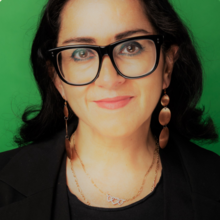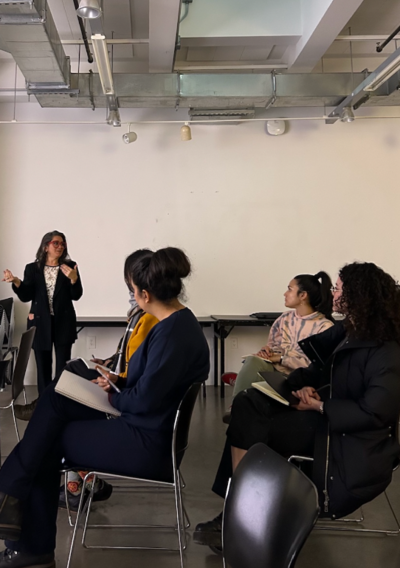‘Latinx Art is American Art’ : Curator Talk with Dr. Rocio Aranda-Alvarado

On Friday, February 23rd the Council on Latin American & Iberian Studies (CLAIS) at the Yale MacMillan Center and the Yale School of Art collaborated to bring the the artist Rocío Aranda-Alvarado on campus to for a talk, an exhibit, and other activities. Aranda-Alvarado earned her Ph.D. in art history from the Graduate Center, City University of New York and served as curator at El Museo del Barrio and the Jersey City Museum, where she started working close to the local community. That experience inspired her to see how she could create connections with more artists and support local art created by Latinx artists. During her talk at Yale School of Art, she delved into the story of El Museo del Barrio and the role and importance of community created museums.
Dr Aranda-Alvarado delved deep into the rich history and transformative impact of El Museo del Barrio in New York City, shedding light on its origins, pivotal moments, and ongoing mission of cultural empowerment. Drawing from the museum’s roots in the fervent activism of the 1960s and 70s art workers coalition protests at MoMA, she painted a vivid picture of the struggles faced by Black and Puerto Rican artists in a city where cultural equity was yet to be realized.

At the heart of El Museo’s genesis stands Raphael Montañez Ortiz, a visionary artist who epitomized the ethos of creative deconstruction as a means of expression. He was disenchanted with the lack of representation in mainstream institutions in a city that was populated by black and Puerto Rican artists. Protests asking for new public schools curriculums that represented the history of Puerto Rican children that attended along with Ortiz’s determination for change led to the birth of El Museo del Barrio and Taller Boricua.
Aranda-Alvarado underscored the profound significance of El Museo as a catalyst for change, noting its role as one of the first institutions to showcase traveling exhibitions, thereby amplifying the voices of marginalized artists. She highlighted notable figures associated with Taller Boricua, such as Marcos Dimas and Carlos Osorio, whose contributions exemplify the museum’s reach within the artistic community. Graduate student Taina Cruz (Yale School of Art MFA’25) shared that she grew up visiting El Museo, and the work Rocio did within that community shaped her experience, influencing her artistic development. She gives thanks to the team at El Museo and to Rocio Aranda-Alvarado for that experience.
As demographics shift and Latinx populations grow, El Museo’s relevance continues to expand. Aranda-Alvarado highlighted landmark exhibitions like The S-files/La bienal, which provided a platform for Latinx artists to explore their identity and heritage. The 2011 edition focused on the aesthetics of the streets in a context of inflation in which the artists struggled deeply. Performances in Times Square by artists such as Guadalupe Maravilla and Nicoykatiushka, together with works by Sofia Maldonado, Johanna Unzueta and Hanelle iglesias who used objects that were found on the streets, captured the vibrancy of Latinx culture.
Other works that found a place in the museum were the installment by graffiti artist Cope2, the Paper Bag Test by Firelei Baez, Reserved Ancestry by Sean Paul Gallegos, the gathering of NYPD sketches by Ignacio González-Lang and movable performance sculptures by Alejandro Guzmán.
The talk also addressed the ongoing challenges faced by small community museums, emphasizing the importance of community involvement and support. Aranda-Alvarado reiterated El Museo’s commitment to inclusivity through initiatives like the Latinx Artist Fellowship Program and the museum’s tagline, “El museo es tu museo”, which invites visitors to see the museum as an extension of their own space.
In addition to its ongoing commitment to showcasing contemporary Latinx art, El Museo del Barrio organized an exposition on the Young Lords in New York, which explored the legacy of the Young Lords and depicted their bold actions to confront inequality and advocate for their community. From the symbolic “garbage offensive” to their relentless campaigns for improved health resources and revolutionary societal changes, the Young Lords embodied the spirit of activism.
As the narrative around Latinx identity continues to evolve, Aranda-Alvarado emphasized the importance of active participation and community engagement. She encouraged artists to be proactive in sharing their work, forging connections, and challenging existing narratives.
In conclusion, Aranda-Alvarado’s talk offered a compelling testament to the transformative potential of art and the enduring legacy of El Museo del Barrio as a champion of Latinx culture and creativity. By honoring its past and embracing its future, El Museo continues to inspire and empower generations of artists and activists alike.
Instagram: @100latinartists

By Katherina Frangi
Ph.D. Student in Spanish and Portuguese
